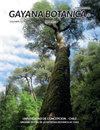标题波罗的海国家的苋属植物
IF 0.5
4区 生物学
Q4 PLANT SCIENCES
引用次数: 0
摘要
摘要:本文介绍了近百年来波罗的海国家草属植物的分类多样性、分布格局和动态。进行了野外研究和植物标本室材料分析。通过比较到1990年和1991年至今这两个时期的所有已知地点,分析了其分布动态。对植物标本馆资料的分析证实,目前在波罗的海国家有四种:Corispermum hyssopifolium, C. declinatum, C. intermedium和C. pallasii。东波罗的海地区唯一的特有种是C. intermedium,被认为是在胚胎移动沙丘和其他沿海生境上的典型一年生植被。在立陶宛,这个物种被认为已经灭绝或几乎灭绝,因为30多年来没有发现过,只有它与C. pallasii的杂交。在拉脱维亚的Rīga湾东岸发现了最大和最稳定的中间C.种群。其他种类,如短生植物C. hyssopifolium和C. declinatum也喜欢干燥和受干扰的栖息地。近年来,这两种情况都变得不那么频繁了。然而,该地区已观察到潜在入侵的pallasii,其分布动态不断增加。爱沙尼亚和拉脱维亚的植物标本分析证实,所有在重新检查后被鉴定为C. algidum的标本都被鉴定为C. pallasii或C. intermedium,更常见的是C. intermedium × C. pallasii的杂交品种。本文章由计算机程序翻译,如有差异,请以英文原文为准。
The Genus Corispermum L. (Amaranthaceae) in the Baltic States
Abstract The paper presents the data on taxonomical diversity and distribution patterns and dynamics of the Corispermum species in the Baltic States over the last hundred years. Field studies and the herbarium material analyses were carried out. The distribution dynamics was analysed by comparing all known localities of the Corispermum species in two time periods: by 1990, and from 1991 to the present. Analysis of the herbarium material confirmed that currently there are four species in the Baltic States: Corispermum hyssopifolium, C. declinatum, C. intermedium and C. pallasii. The only endemic species to the Eastern Baltic Region, C. intermedium, is considered as typical for annual vegetation on embryonic shifting dunes and other coastal habitats. In Lithuania, this species is considered extinct or almost extinct, as has not been found for more than 30 years, only its hybrids with C. pallasii. The largest and most stable population of C. intermedium has been found on the eastern shore of the Gulf of Rīga in Latvia. Other species such as ephemerophytic C. hyssopifolium and C. declinatum also prefer dry and disturbed habitats. Both have become less frequent in recent years. However, potentially invasive C. pallasii has been observed in the region with increasing distribution dynamics. The Estonian and Latvian herbaria analysis confirmed that all specimens previously identified as C. algidum after re-examination were identified as C. pallasii or C. intermedium and more often as hybrid C. intermedium × C. pallasii.
求助全文
通过发布文献求助,成功后即可免费获取论文全文。
去求助
来源期刊

GAYANA BOTANICA
Agricultural and Biological Sciences-Plant Science
CiteScore
0.70
自引率
0.00%
发文量
8
审稿时长
6-12 weeks
期刊介绍:
The journal welcomes works carried out by scientists of all nationalities, and may be written in either English or Spanish. The journal receives works in systematic, taxonomy, floristic, ecology, physiology, morphology, development, conservation, cytology and phytochemical botany.
 求助内容:
求助内容: 应助结果提醒方式:
应助结果提醒方式:


